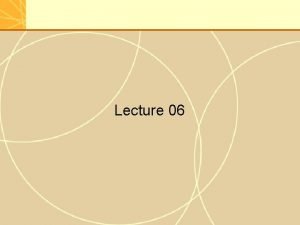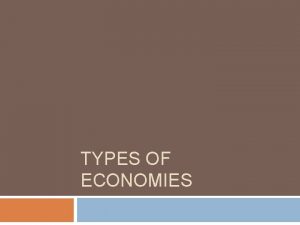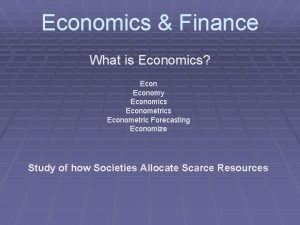Economics for a changing world THE ECONOMY THE








- Slides: 8

Economics for a changing world THE ECONOMY: THE CORE PROJECT

Economics for a changing world UNIT 1. THE CAPITALIST REVOLUTION

T 1. 1 Nominal GDP in Japan The following table shows the nominal GDP (in 2015 US dollars) and the population of Japan in 2013 and 2014 (source: The World Bank). Based on this information, which of the following statements regarding GDP per capita is correct? Select one answer a. Japan’s GDP per capita in 2013 was $36, 194. 42. b. Japan’s GDP per capita fell by 6. 74% between 2013 and 2014. c. The fall in the population was enough to offset the fall in GDP, for an overall growth in GDP per capita between 2013 and 2014. d. Japan’s GDP per capita fell by 6. 31% between 2013 and 2014. Section 1. 1

ANSWER: T 1. 1 Nominal GDP in Japan The following table shows the nominal GDP (in 2015 US dollars) and the population of Japan in 2013 and 2014 (source: The World Bank). Based on this information, which of the following statements regarding GDP per capita is correct? Select one answer Feedback a. Japan’s GDP per capita in 2013 was $36, 194. 42. a. b. Japan’s GDP per capita fell by 6. 74% between 2013 and 2014. c. The fall in the population was enough to offset the fall in GDP, for an overall growth in GDP per capita between 2013 and 2014. The GDP per capita in 2013 was $4, 919, 563, 108, 372. 50 / 127, 338, 621 = $38, 633. 71. $36, 194. 42 is for the GDP per capita in 2014. b. The GDP per capita was $38, 633. 71 in 2013 and $36, 194. 42 in 2014. Therefore it changed by (36, 194. 42 – 38, 633. 71) / 38, 633. 71 = -6. 31%. c. The population fell by 0. 16%. This was not enough to offset the fall in GDP of 6. 47%. d. The GDP per capita was $38, 633. 72 in 2013 and $36, 194. 42 in 2014. Therefore it changed by (36, 194. 42 – 38, 633. 71) / 38, 633. 71 = -6. 31%. d. Japan’s GDP per capita fell by 6. 31% between 2013 and 2014. Section 1. 1

T 1. 2 Nominal and real GDP Eden, a country, produces just two output goods: apples and snakeskin handbags. In 2014 the prices of apples and handbags were $10 and $24, respectively. In 2015, the prices increased to $12 and $25. The quantities produced of the two goods were 100 and 20, respectively, in both 2014 and 2015. From this information, we can conclude that: Select all correct answers a. The nominal GDP in 2014 is $1, 480. b. The real GDP is unchanged between 2014 and 2015. c. The nominal GDP growth rate between 2014 and 2015 is 14. 9%. d. The economy of Eden grew between 2014 and 2015 in real terms. Section 1. 2

ANSWER: T 1. 2 Nominal and real GDP Eden, a country, produces just two output goods: apples and snakeskin handbags. In 2014 the prices of apples and handbags were $10 and $24, respectively. In 2015, the prices increased to $12 and $25. The quantities produced of the two goods were 100 and 20, respectively, in both 2014 and 2015. From this information, we can conclude that: Select all correct answers Feedback a. The nominal GDP in 2014 is $1, 480. a. The nominal GDP in 2014 is (10 x 100) + (24 x 20) =$1480. b. The real GDP is unchanged between 2014 and 2015. b. c. The nominal GDP growth rate between 2014 and 2015 is 14. 9%. The quantities produced (total output) did not change between 2014 and 2015, so real GDP also did not change. c. The nominal GDP in 2014 is $1480 and the nominal GDP in 2015 is $1700. The growth rate is therefore (1700 – 1480)/1480 = 14. 9%. d. Here, the increase in the nominal GDP between the two years is purely due to the price increase. Therefore in real terms the economy did not grow. d. The economy of Eden grew between 2014 and 2015 in real terms. Section 1. 2

T 1. 3 Private property, markets, and firms Capitalism is an economic system in which, private property, markets, and firms play an important role. Which of the following statements related to the terms in this definition are correct? Select all correct answers a. An economic system is a way of organising the production and distribution of goods and services in an entire economy. b. The knowledge you attain from the CORE programme is considered private property. c. Forced labour where the workers receive some daily allowance is an example of a market. d. Employee-owned cooperatives are not firms. Section 1. 6 -1. 7

ANSWER: T 1. 3 Private property, markets, and firms Capitalism is an economic system in which private property, markets, and firms play an important role. Which of the following statements related to the terms in this definition are correct? Select all correct answers Feedback a. This is the definition of economic system (see Unit 1. 6). An economic system is a way of organising the production and distribution of goods and services in an entire economy. b. The knowledge you attain from the CORE programme is considered private property. c. Forced labour where the workers receive some daily allowance is an example of a market. d. Employee-owned cooperatives are not firms. b. Human capital is something that you can use in the way that you choose and can exclude others from using. However, it is still not considered private property as you cannot give or sell it directly to others for them to become the owners. c. Forced labour is not a market, as the exchange of labour and allowance is not voluntary. d. Employee-owned cooperatives are productive organisations, but are not firms because the owners are not private individuals who own the assets of the firm and employ others to work there. Section 1. 6 -1. 7
 The economy: economics for a changing world
The economy: economics for a changing world Answert the public
Answert the public The changing world output and world trade picture
The changing world output and world trade picture The changing world output and world trade picture
The changing world output and world trade picture Changing role of government in the economy
Changing role of government in the economy Athens and sparta were both
Athens and sparta were both Traditional economy definition economics
Traditional economy definition economics Traditional economy definition economics
Traditional economy definition economics Three basic questions of economics
Three basic questions of economics














